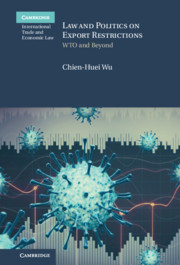Book contents
- Law and Politics on Export Restrictions
- Cambridge International Trade and Economic Law
- Law and Politics on Export Restrictions
- Copyright page
- Dedication
- Contents
- Preface
- Table of Legislation
- Table of Cases
- Acronyms and Abbreviations
- 1 Introduction
- 2 WTO Rules on Export Restrictions
- 3 Governing Export Restrictions
- 4 Export Restrictions in the Global Supply Chain
- 5 Conclusion
- Bibliography
- Index
1 - Introduction
Published online by Cambridge University Press: 09 July 2021
- Law and Politics on Export Restrictions
- Cambridge International Trade and Economic Law
- Law and Politics on Export Restrictions
- Copyright page
- Dedication
- Contents
- Preface
- Table of Legislation
- Table of Cases
- Acronyms and Abbreviations
- 1 Introduction
- 2 WTO Rules on Export Restrictions
- 3 Governing Export Restrictions
- 4 Export Restrictions in the Global Supply Chain
- 5 Conclusion
- Bibliography
- Index
Summary
The GATT/WTO regime is built on an export-bias, with trading nations aiming to export goods and services while keeping foreign producers from their domestic market so as to protect domestic producers from competition. Therefore, the vast majority of WTO rules are concerned with regulation on the liberalisation of import restrictions, tariffs and non-tariff barriers, but touch only lightly on export restrictions. The emphasis on the liberalisation of import barriers can be attributed to the built-in mercantilist tendencies of the GATT/WTO system – an arm of the post-World War II international economic order – and viewed as a direct response to the earlier erection of insurmountable import tariffs, which led to the Great Depression and the accompanying political turmoil. The weaknesses of such one-sided regulation out of export-bias are exposed by the proliferation of export restrictive measures adopted in the name of national security and in a time of pandemic. Export restrictions may pose great challenges to the global supply chain, given the geographical distribution of production chains out of economic globalisaiton, and exacerbate food insecurity of food-importing countries.
Keywords
Information
- Type
- Chapter
- Information
- Law and Politics on Export RestrictionsWTO and Beyond, pp. 1 - 19Publisher: Cambridge University PressPrint publication year: 2021
